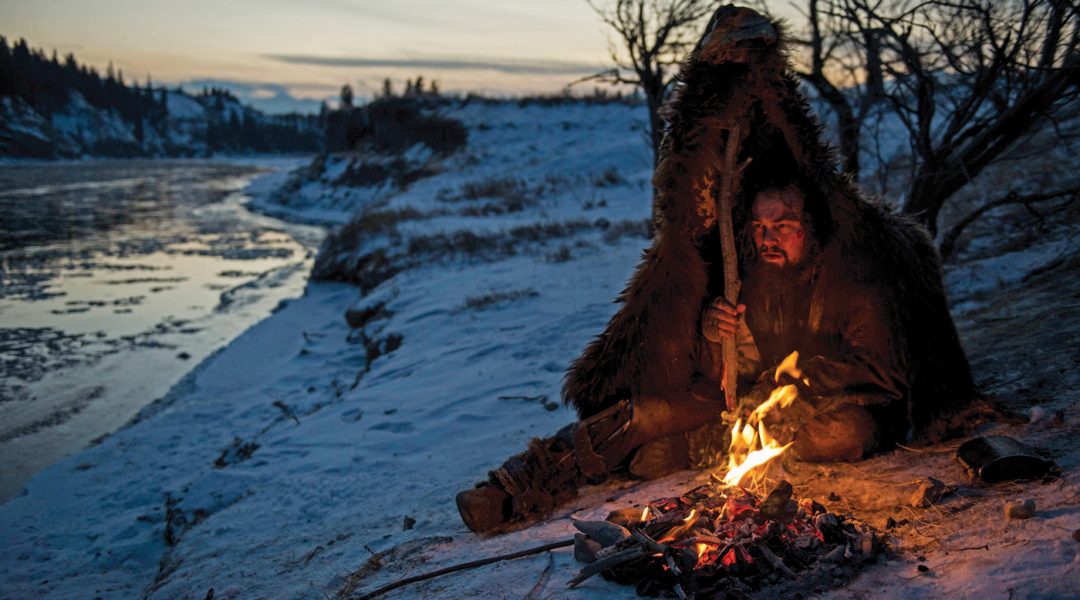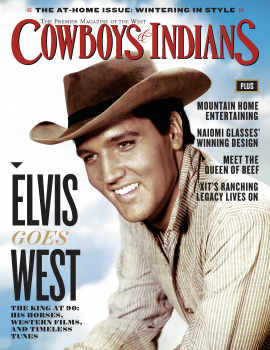In director Alejandro G. Iñárritu’s spectacular new tale of survival and revenge on the brutal 1800s American frontier, Leonardo DiCaprio takes the lead as true-to-life stuff-of-legend Hugh Glass.
There’s already been talk of Academy Awards. Lots of talk, too, about the brutal cold during filming. And, no kidding, a bunch of talk about the beard.
If you’ve seen pictures of Leonardo DiCaprio with prodigious facial hair over the last year, you might have thought he’d gone all mountain man. And you’d have been right. He started sporting the bushy beard while getting ready for seven months of filming in frigid locations for the frontier revenge adventure The Revenant. Nasty rumors (started in a tabloid) that fleas had infested the beard were dismissed categorically by the film’s production company.
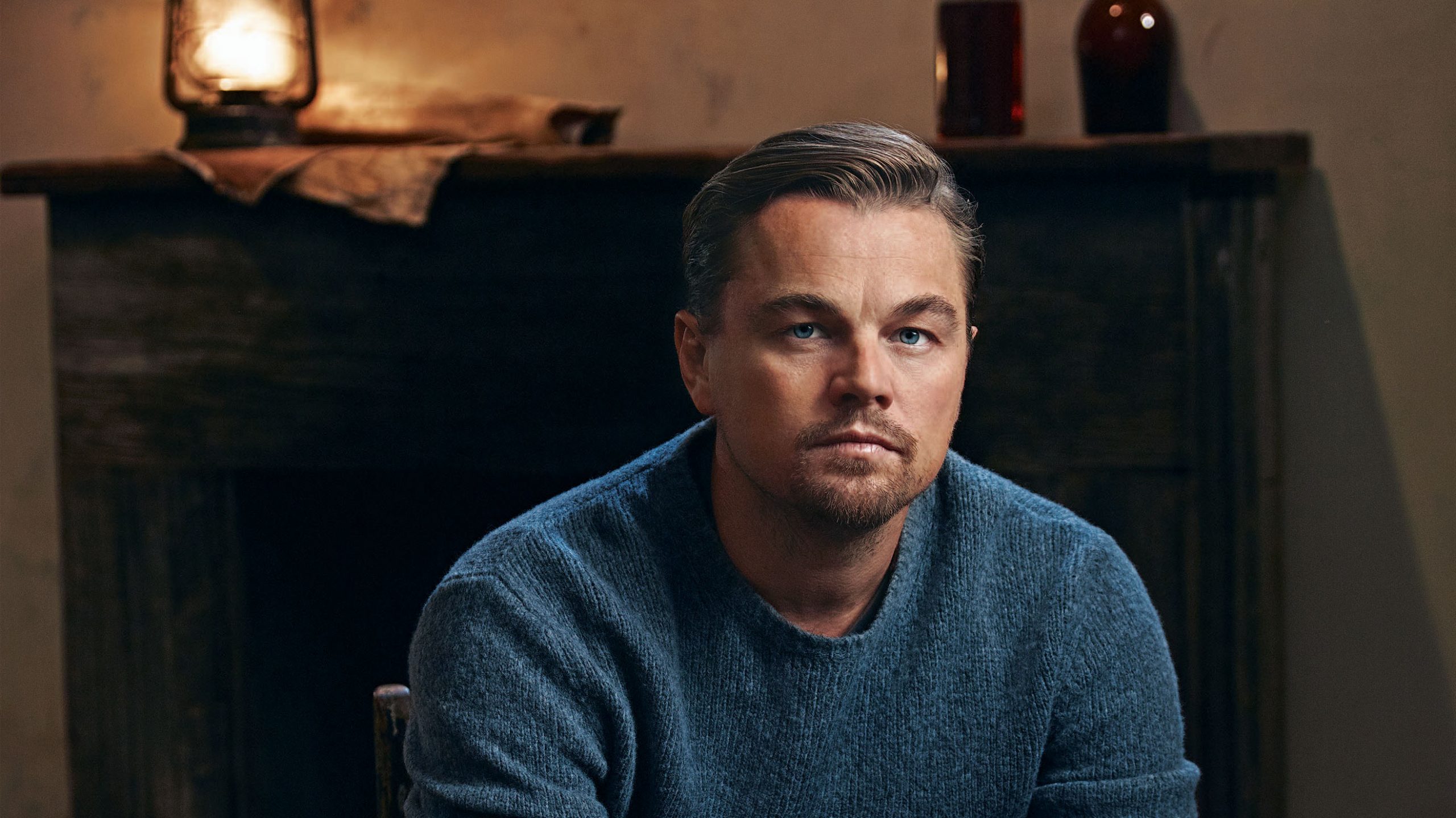
Credit the beard (fleas or not), the take-no-prisoners acting and directing, and the extreme conditions DiCaprio (and everyone else on location) had to endure with transforming the normally handsome, stylish actor into a believable revenant. The word conjures up images of zombies, ghosts, and those left for dead who come back to wreak havoc or exact retribution on the living. Or as Merriam-Webster puts it: “one that returns after death or a long absence,” usually motivated by revenge.
The word is sure to be added to the collective vocabulary after Academy Award-winning director Alejandro G. Iñárritu’s new film opens on Christmas Day, but the theme has long been a favorite in westerns: A fearsome or mysterious character — Eastwood as The Stranger in 1973’s iconic High Plains Drifter immediately comes to mind — returns from some unspeakable injustice hellbent on vengeance. As revenants go, the real-life tale of Hugh Glass is a case of truth being at least as strange as fiction — and certainly as dramatic.
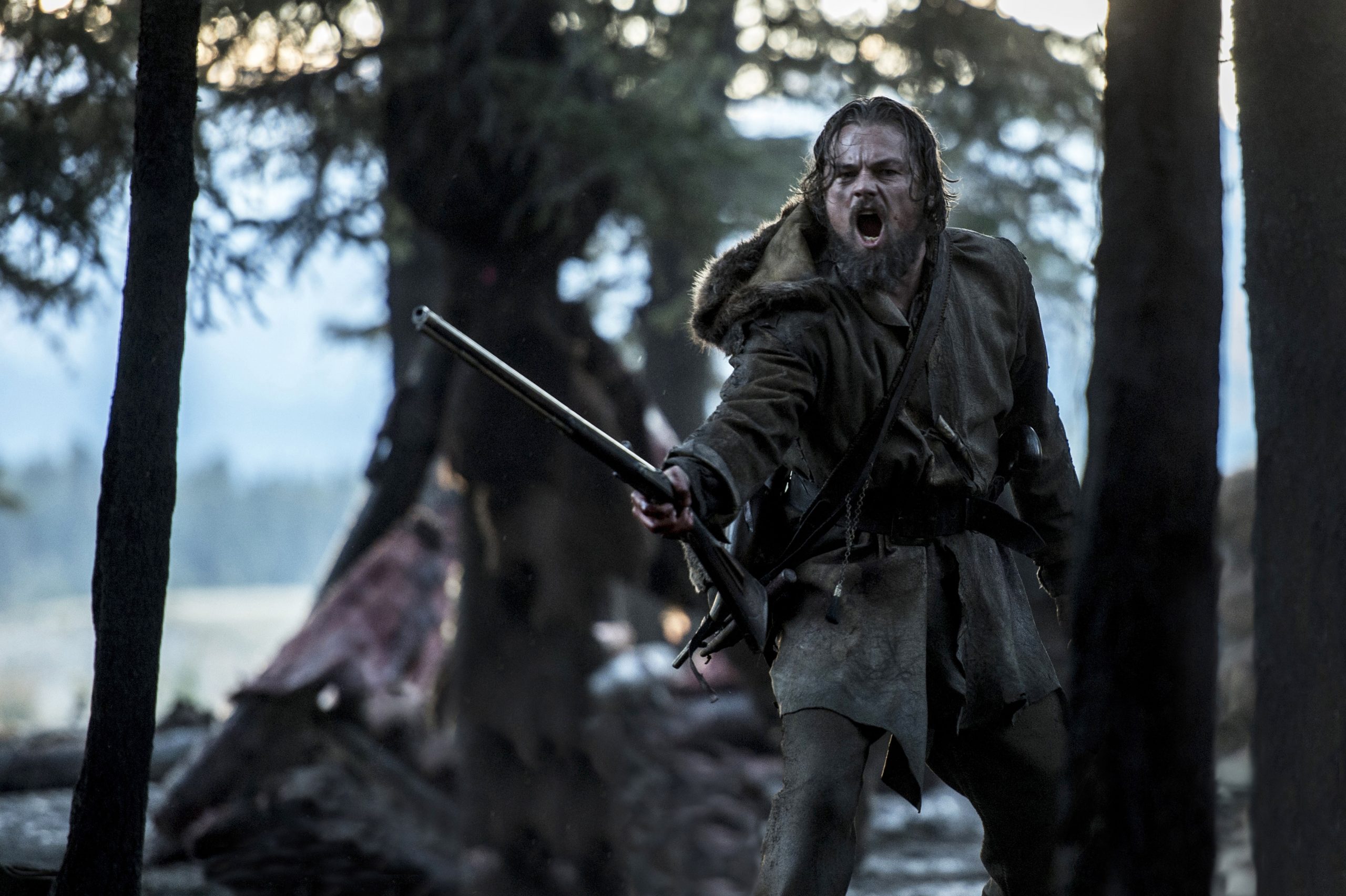
DiCaprio stars as Glass, an expert hunter and fur trapper, nearing or in his early 40s, who worked for Gen. William Ashley’s Upper Missouri River expedition. Mauled by a grizzly bear in the fall of 1823, he was left for dead by two members of the expedition, John Fitzgerald (Tom Hardy) and a teenage Jim Bridger (Will Poulter), who had been directed to tend to Glass until he died, give him a proper burial, and then catch up with the outfit. But believing hostile Natives were near, they instead buried him alive and stole his rifle and supplies. Against all odds, Glass lived to forage more than 200 miles to take retribution, and ultimately the extreme experience transformed him into a mountain man legend.
Iñárritu wasn’t the first to recognize the dramatic potential of the Hugh Glass story. The 1971 film Man in the Wilderness, loosely based on Glass’ travails, saw Irish actor Richard Harris as Zachary Bass, who is similarly left for dead by fellow trappers after a bear attack and lives to exact revenge. This time on the big screen, the story of the legendary survivor is inspired by true events and based in part on the historical novel The Revenant: A Novel of Revenge by Michael Punke — but it’s all about Iñárritu’s and DiCaprio’s uncompromising vision.
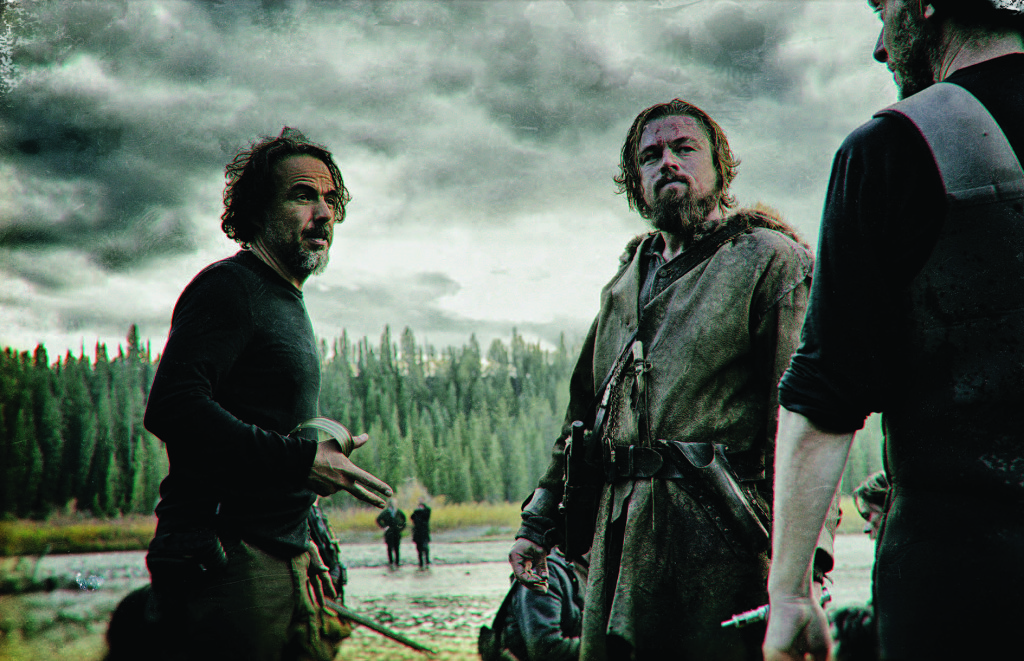
“Alejandro and I were searching for the revenant theme throughout the film. It’s a very linear theme worth exploring,” DiCaprio says. “This is a man who loses his son, gets buried alive after a tragic bear attack, and comes back to wreak revenge on those who done him wrong. Hugh Glass is stripped of everything and is a broken man. The only thing that moves him forward is that retribution and revenge, but ultimately through that journey, he’s faced with that decision and makes a different choice. His journey has changed him.”
Iñárritu was especially interested in the aspect of transformation: “One of the producers on the film sent me a very early draft of the script,” he says. “The story was really simple, and I was less interested in this survival tale than in Glass’ endurance, the love under the pain, and the possibility of his spiritual transformation.”
If the shrinks and self-help books are right, transformative change generally doesn’t come without some kind of pain — and there was plenty of that both on the frontier and on location. In reality, Glass’ trek to civilization was set against the backdrop of what is now South Dakota in the 1820s. The movie, however, was actually filmed mostly in the Canadian wilderness in bitter temperatures and snow.
Iñárritu, known for railing against the niceties of modern film production and the resulting lack of true adventure (“We have GPS. We will never get lost,” he once complained to Entertainment Weekly), opted for no safe soundstages and very little green screen. With the director insisting that things be as authentic as possible on set, a couple of fleas would have been the least of DiCaprio’s concerns. Nobody died on location, but it was so cold for so long that some folks quit the picture — with plenty of subsequent kvetching in the press. And while some 300 cast and crew made it from start to finish, even the director allowed that “they were [bleeping] miserable.”
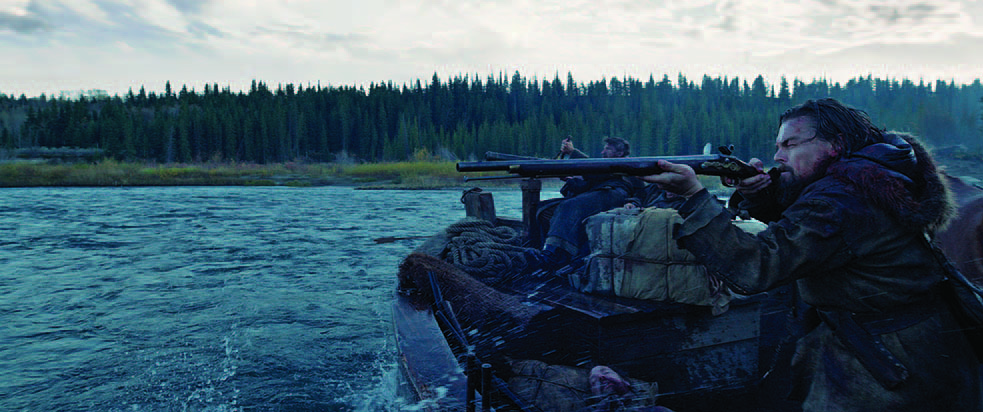
In Iñárritu’s world, that’s the price of epic filmmaking. “Making this film was such an odyssey,” he says. “We had to learn how to survive like the real trappers and explorers did almost 200 years ago; we survived on just 10 percent of traditional comforts, which were the furs and heavy coats we all wore to ward off the extreme cold.”
DiCaprio went in with his eyes open. “If I was going to play this character, I knew I had to embody him the best I could and there was no room for movie star tantrums,” he says. “If I was going to tackle this character, I’d have to dive in head first. Every day was a unique challenge, trying to find a way to not have me freeze. We were shooting in a real environment with natural light, so we were constantly in the elements, pushing ourselves as hard as we could to tell this man’s story.”
The 2015 Academy Award winner for Best Director for Birdman (“This guy’s as bold as bold can be,” said Michael Keaton on Oscar night, when he was nominated for Best Actor for the film), Iñárritu led cast and crew far into the British Columbia and Alberta wilderness to capture the difficult reality of the lives of mountain men.
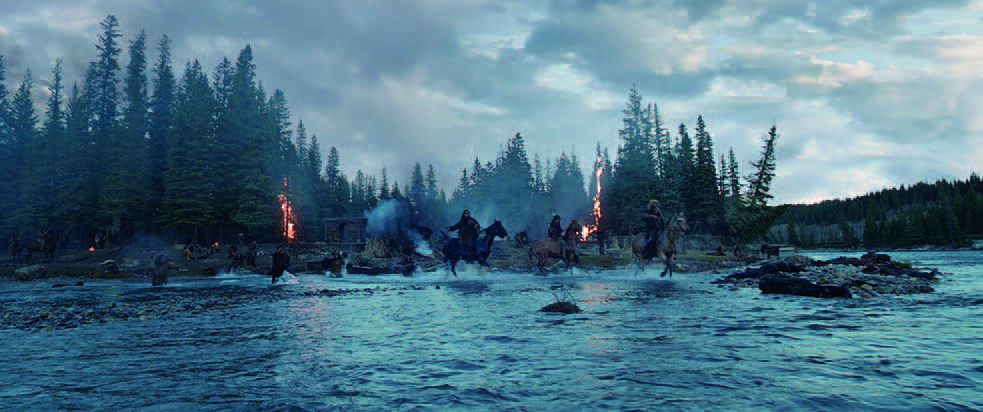
“This story is about the resilience and endurance of a heroic man who had to learn to survive in this unforgiving countryside,” says the director, who also co-wrote and produced the film. “The filmmakers and crew spent months and months in the cold and wilderness, and in a way it was a transformative experience. We were exposed 15 hours a day to the mercy of the weather, with no communication outside of the location. Even going to the bathroom in the frigid cold was a challenge. The unstable weather made us constantly change our plans, so we had to develop a trapper type of spirit, just like the men who traveled and explored before us. To touch that reality made us really appreciate what we have and think about what these explorers went through to survive.”
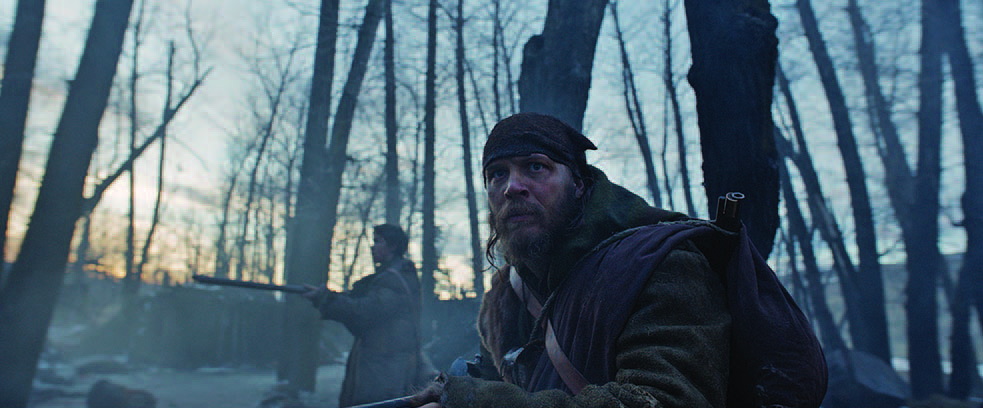
Before there were lines to memorize, marks to hit, and cold to survive, DiCaprio and other cast members began their work on the film by reading firsthand accounts written by trappers from the same era and location on the Upper Missouri River.
“Without collaboration, there would never be the chance to move on past the next valley,” DiCaprio says. “Everyone needed to work together. I think that’s why Hugh Glass was such a legend in America — because he was a man absolutely left for dead and was able to survive in the harshest of winters completely on his own. In reading these journals, I was amazed to find out what these men had to work with and used to fight with. It took minutes to reload just one bullet. The conditions were very primal — close to what you imagine cave men lived in.”
Iñárritu was keen to capture that reality, whatever it took, and DiCaprio didn’t flinch. “Glass has seen death firsthand,” DiCaprio says, “so Alejandro and I decided to let nature dictate his path, being immersed in that environment. It’s the closest thing you’ll feel to a documentary. The audience will be a voyeur — like a fly flying around in the forest — the closest thing to getting into these characters’ heads, watching the vast landscapes, feeling like you’re completely immersed in the environment.”
British actor Will Poulter, who was a mere 21 years old when he landed the role of trapper, explorer, and guide Jim Bridger — who himself was only 18 when he met up with Hugh Glass — came away from the experience believing the mountain men were “kind of superhuman.” “We’ll never truly understand how bad the weather was that these men had to face,” he says, “but we did get a taste of those terrible conditions. It was amazing to discover what one human being could endure and the strength of the human spirit.”
Poulter anticipated the filming would be very difficult, but was surprised by Iñárritu’s ability to use the harsh conditions to his benefit. “We ended up shooting longer than expected because the weather was so changeable, and we did end up running out of snow. But Alejandro made it a point to use the weather to our advantage instead of making it the enemy,” Poulter says. “One of the central themes in the movie is Hugh Glass’ relationship with the weather and will he survive.”
Committing fully to that question required a certain fearlessness on everyone’s part, whether it was Iñárritu moving the production to another hemisphere when filming went so far into the summer that they lost snow and had to go to Patagonia at the southern end of South America to find enough, or DiCaprio repeatedly getting into an icy river with a wetsuit underneath his costume but fully exposed hands that afterward needed to be kept from frostbite with an industrial blow dryer. A few days of that — let alone seven months — and the mindset must have approached a moviemaking version of what Glass declares in the film: “I ain’t afraid to die anymore. I already done it.”
All out, and all in.
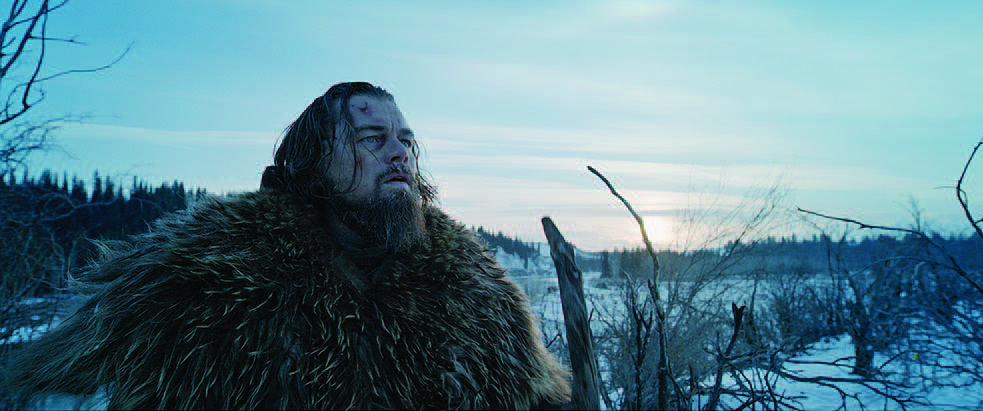
You might not necessarily peg the kid who was rumored to have been kicked off Romper Room at age 5 for being disruptive as a thinker. But Leonardo DiCaprio’s more than just a pretty face. He speaks German fluently, he’s building an eco-friendly resort on an island he bought off the coast of Belize, and he has his own nonprofit, the Leonardo DiCaprio Foundation, which supports — to the tune of a lot of money — innovative projects that protect biodiversity and endangered wildlife, conserve wildlands and the ocean, and seek to understand climate change.
A pretty serious sort, it turns out — despite the boyish good looks and penchant for dating models (he is now reportedly engaged to bikini beauty Kelly Rohrbach) — a fact that comes into sharp focus on review of his award-strewn résumé. Before he was even 20, he earned an Academy Award nomination for Best Supporting Actor for his role as Arnie Grape, Johnny Depp’s younger developmentally challenged brother in What’s Eating Gilbert Grape. He had clearly arrived on the scene when he followed that up playing Jim Carroll in 1995’s The Basketball Diaries, Carroll’s harrowing autobiographical tale of descent into drug addiction. But it would be his breakout role as the young, romantic, and ultimately tragic Jack Dawson opposite Kate Winslet in James Cameron’s 1997 epic drama Titanic that would make DiCaprio a huge international star.
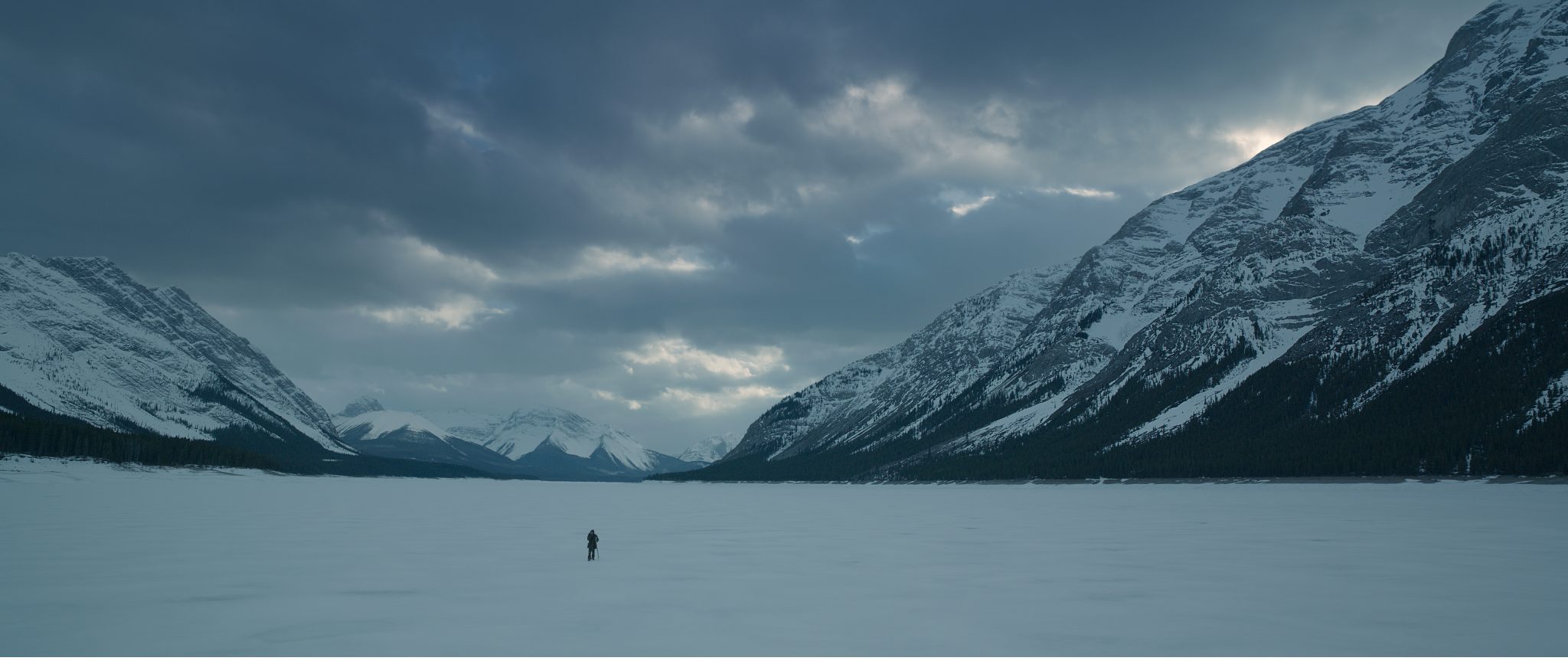
For the more than 15 years since, he has tackled a host of diverse roles that defy the baby face. He’s played Howard Hughes in Aviator, con man Frank Abagnale in Catch Me If You Can, working stiff Frank Wheeler in the relationship drama Revolutionary Road, 19th-century revenge-seeking ruffian Amsterdam Vallon in Gangs of New York, professional thief and dream infiltrator Dom Cobb in the sci-fi hit Inception, undercover cop Billy Costigan in The Departed, and white Rhodesian gun runner Danny Archer in the Sierra Leone political war thriller Blood Diamond. More recently, he memorably became evil plantation owner Calvin Candie in Quentin Tarantino’s spaghetti western Django Unchained and the titular “wolf” Jordan Belfort in The Wolf of Wall Street. He’s even been Jay Gatsby, for Pete’s sake.
It’s a film résumé full of snappy dialogue, something DiCaprio, who’s been nominated for five Academy Awards but has yet to win, is particularly good at. For The Revenant, though, it would be neither pretty face nor witty dialogue that would allow him to draw in the audience. He needed a different set of chops to compel and communicate mainly without words.
“All my characters have been incredibly articulate in what they’re feeling and drive the story along by their sheer will and emotion,” DiCaprio says. “[The Revenant] is a completely different exercise and felt very much like doing a period silent film. Most of the dialogue I have is Pawnee language, and this western frontier [after] Lewis and Clark was very much like the Amazon — it’s uncharted territory. Glass is in the middle of this wilderness, where he is living with the indigenous population and wants to disappear from society. But this choice comes back to haunt him and really affect his life in a major way.”
As much as history has recounted the story of Hugh Glass, DiCaprio says, “There’s ultimately very little known about this campfire legend. What I had to do was to strip away most of the dialogue and create an existential connection with nature and find what drives him to push forward against all odds and to survive in the hardest of conditions. It was silent acting in a way.”
For the seasoned actor, it was fascinating to have to try to find a way to tell the story through Glass’ actions and emotions. “You always know the camera’s there, but when you have no one else to bounce your scene off of and are in nature, all this has to be done with very subtle brushstrokes. At the same time, you need to move the character and story along. You have to pretend that no one is watching, and that was the challenge for me.”
All while freezing your you-know-what off.
In the end, DiCaprio really does live up to the beard. And he manages to convey — in silence, in Pawnee, in rising to the real-life challenges of the role — that Hugh Glass represents much more than the calamities of fate and climate he managed to survive.
“He represents that American spirit, the frontiersman in the new land,” DiCaprio says. “What I learned from his real-life story is that there’s so much more in all of us than we think there could possibly be. Ultimately what is so inspiring about Hugh Glass is that he had every reason to give up and let go. Instead, he chose to survive and went on to do great things.”
From the January 2016 issue.
Photos courtesy of Kimberley French/Courtesy Twentieth Century Fox and Twentieth Century Fox Film Corporation.
THE REVENANT Motion Picture Copyright © 2015 Regency Entertainment (USA), Inc. and Monarchy Enterprises S.a.r.l.






